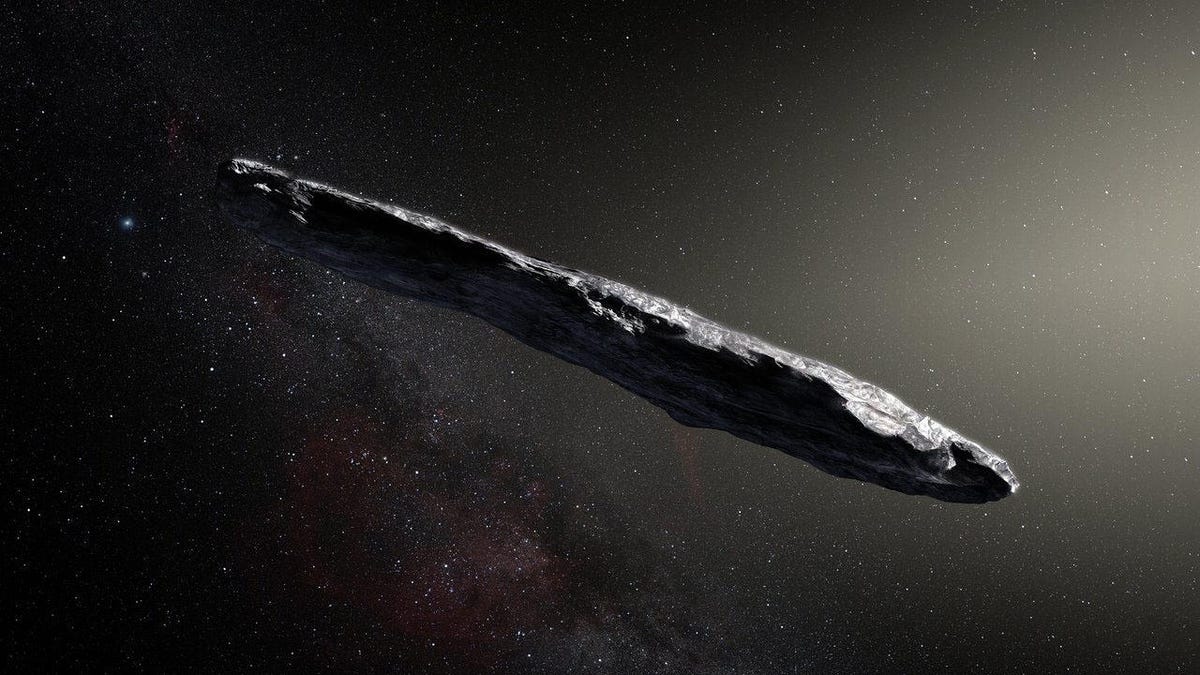Interstellar comet Borisov looks ordinary, making Oumuamua even weirder
Visitors from deep space might come in all shapes and sizes.

This artist's impression shows the first interstellar asteroid: Oumuamua.
One of the first profiles of interstellar comet Borisov has been published, and it looks about the same as most other comets. What it doesn't look like is the first interstellar object, Oumuamua, which made its closest pass by Earth exactly two years ago today.
A paper published Monday in Nature Astronomy lays out the early data on Borisov, which is just the second-ever object seen visiting our solar system from beyond. While scientists will get a better look as the comet comes closer to Earth over the next several weeks, so far it looks to be the same color and size as most ordinary comets. Earlier research also revealed it's behaving in familiar ways with a tail containing some of the same toxic gases we expect from intrastellar comets.
"We immediately noticed the familiar coma and tail that were not seen around Oumuamua," said Michal Drahus of the Jagiellonian University in Poland, who co-led the study, in a release. "This is really cool because it means that our new visitor is one of these mythical and never-before-seen 'real' interstellar comets."
2I/Borisov is the first interstellar comet we have ever seen.
The implication here is that Oumuamua was not a "real" interstellar comet, which then leads to the obvious question: So what the heck was it?
Your basic comet, a category that so far includes Borisov, is a typically spheroidal mass of rock and ice that begins to off-gas as it's heated by the sun, producing its distinctive coma, or tail. Oumuamua was an oblong, cigar-shaped mass that didn't show many signs of off-gassing or a coma. Even weirder was the fact that it appeared to accelerate as it flew back out to deep space.
We may never get another look at Oumuamua, as it was first spotted five days after its close approach, already on its way out of the solar system.
Many astronomers now believe that interstellar visitors may be more common than previously thought. Our technologies and techniques are just finally refined enough to detect them. As such, we should expect that we'll discover many more objects from other stars swinging through our neighborhood over the years to come. Perhaps we'll spot more oblong or odd-shaped interstellar space rocks and conclude that Oumuamua wasn't that weird after all.
Or perhaps we won't, which might lend credence to the idea suggested by respected Harvard astronomer Avi Loeb that Oumuamua could be some sort of artificial probe from another civilization. The idea earned Loeb some criticism, and it's an easy idea to float about an object we'll probably never see again.
But Loeb does think we might be able to find evidence of life from other star systems at a much closer location: the moon.
"The idea is to consider the moon's surface as a fishing net for interstellar objects collected over time," he wrote in a column for Scientific American last month.
Loeb argues that if interstellar objects are common, then some of them likely crashed into the moon at some point, leaving well-preserved remnants that might even carry the building blocks of alien critters.
"Identifying biomarkers from debris of material that originated in the habitable zone around other stars would inform us about the nature of extraterrestrial life," Loeb writes. "The fundamental question is whether distant life resembles the biochemical structures we find on Earth. Similarities might imply that there exists a unique chemical path for life everywhere or that life was transferred between systems."
He goes on to make the case that a lunar research base to search for and study such ancient, interstellar fossils could amount to a major shortcut in the search for E.T. compared with undertaking generational missions to visit other stars.
It's been two years since Oumuamua visited us, and it now seems weirder than ever. Even if we never see that strange flying space cigar ever again, its cousins could be inbound now. In fact, Loeb has also argued that we've already been hit by an interstellar meteor.
Bottom line: Our solar system has probably been receiving interstellar visitors for a very long time. Now that they've finally got our attention, we can learn how diverse (and perhaps even lively) a group they really are.

